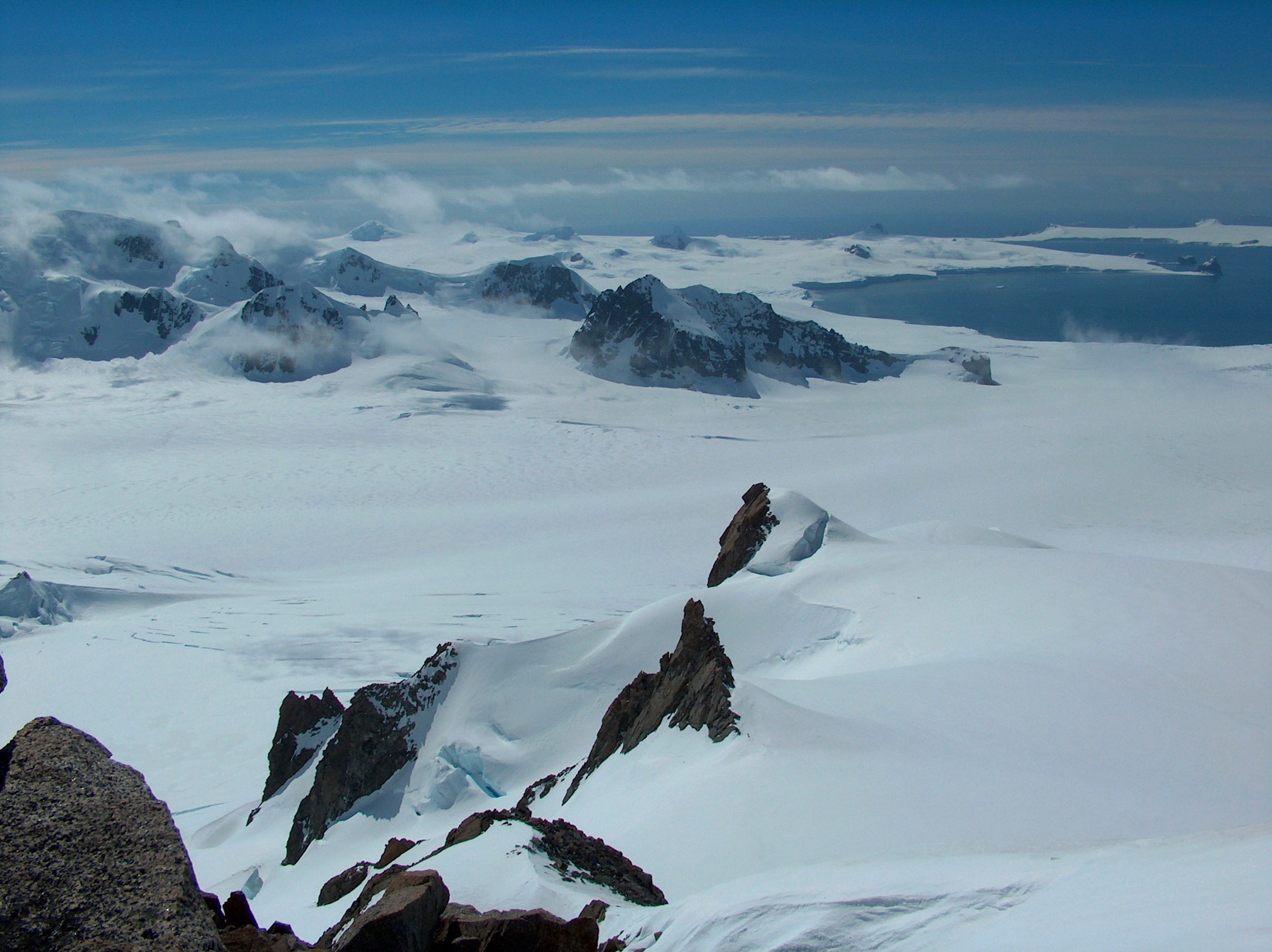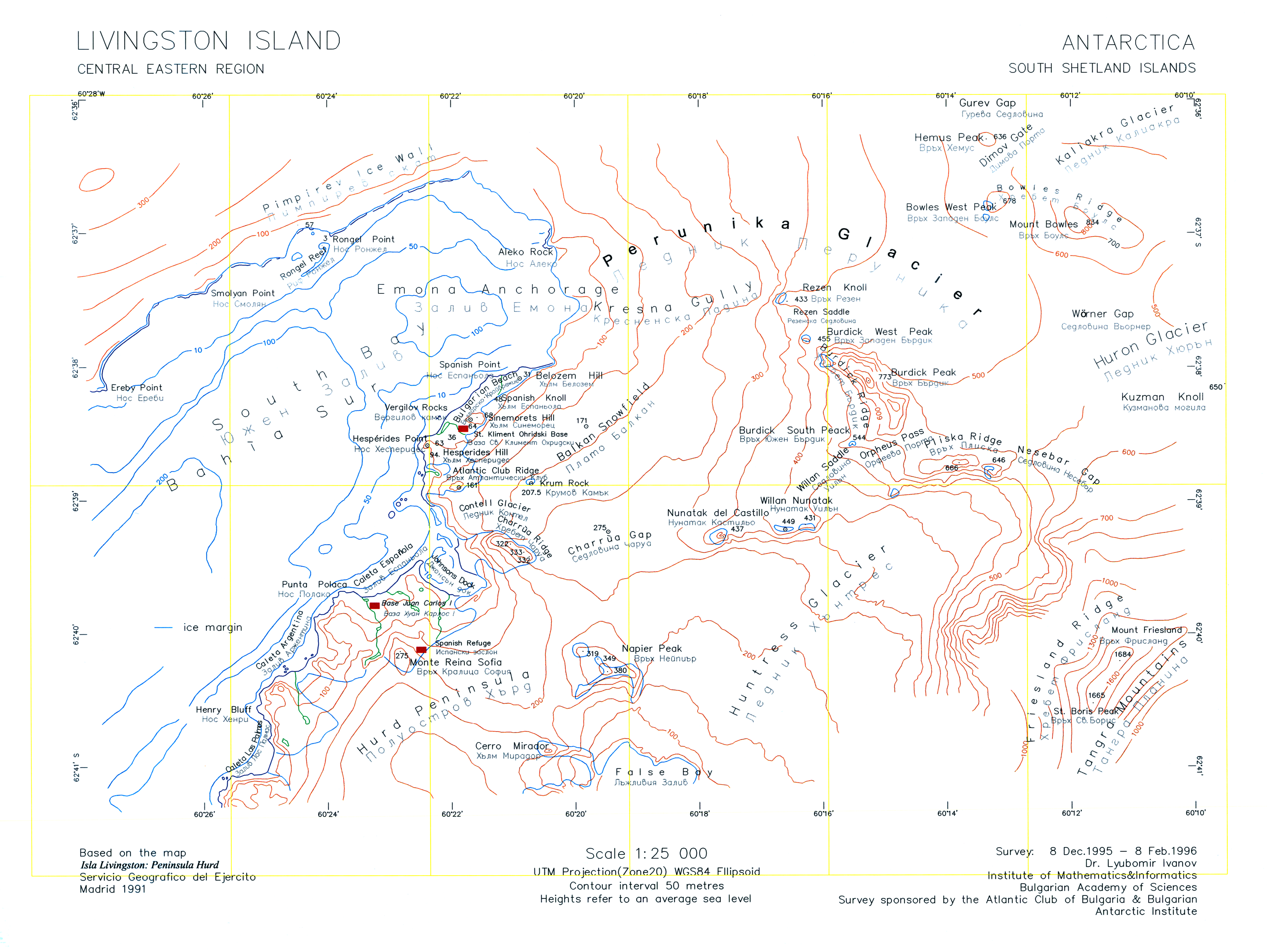|
Bowles West Peak
Bowles West Peak ( bg, връх западен Боулс, vrah zapaden Bouls, ) is a peak rising to 678 m at the western extremity of Bowles Ridge in eastern Livingston Island in Antarctica. The peak has precipitous and partly ice free western slopes and overlooks Perunika Glacier to the southwest. The feature takes its name from Mount Bowles, the summit of the eponymous ridge. Location The peak is located at which is 1 km west by north of Mount Bowles (822 m), 790 m south by east of Hemus Peak, 6.24 km east of Aleko Rock and 3.2 km east by northeast of Rezen Knoll. The peak was roughly mapped by the British in 1968 and the Spanish in 1991. The peak was mapped by Bulgaria from a 1995-96 topographic survey. Maps * L.L. Ivanov et al. Antarctica: Livingston Island and Greenwich Island, South Shetland Islands. Scale 1:100000 topographic map. Sofia: Antarctic Place-names Commission of Bulgaria, 2005. * L.L. IvanovAntarctica: Livingston Island and Greenwich, Ro ... [...More Info...] [...Related Items...] OR: [Wikipedia] [Google] [Baidu] |
Bowles Ridge
Bowles Ridge ( bg, хребет Боулс, hrebet Bouls, ) is the central ridge of eastern Livingston Island. The ridge extends 6.5 km in the east-west direction and is 1.5 km wide. The summit of the ridge is Mount Bowles which rises to 822m and is located 9.77 km northwest of Great Needle Peak, 6.08 km north by west of Mount Friesland, 8.77 km east-northeast of St. Kliment Ohridski base and 9.25 km south by west of Miziya Peak. ''Bowles Ridge'' is bounded by Kaliakra Glacier and Struma Glacier to the north, by Perunika Glacier to the west and southwest and by Huron Glacier to the southeast and east. It is linked to Friesland Ridge of the Tangra Mountains by Wörner Gap, to Hemus Peak by Dimov Gate, and to Melnik Ridge by Yankov Gap. The ridge is crossed by Omurtag Pass and Pirdop Gate. The feature takes its name from Mount Bowles Mount Bowles is an ice-covered mountain high, the summit of Bowles Ridge in the central part of eastern ... [...More Info...] [...Related Items...] OR: [Wikipedia] [Google] [Baidu] |
Livingston Island
Livingston Island (Russian name ''Smolensk'', ) is an Antarctic island in the Southern Ocean, part of the South Shetlands Archipelago, a group of Antarctic islands north of the Antarctic Peninsula. It was the first land discovered south of 60° south latitude in 1819, a historic event that marked the end of a centuries-long pursuit of the mythical ''Terra Australis Incognita'' and the beginning of the exploration and utilization of real Antarctica. The name Livingston, although of unknown derivation, has been well established in international usage since the early 1820s. Geography Livingston Island is situated in West Antarctica northwest of Cape Roquemaurel on the Antarctic mainland, south-southeast of Cape Horn in South America, southeast of the Diego Ramírez Islands (the southernmost land of South America), due south of the Falkland Islands, southwest of South Georgia Islands, and from the South Pole.L. IvanovGeneral Geography and History of Livingston Island.In ... [...More Info...] [...Related Items...] OR: [Wikipedia] [Google] [Baidu] |
Perunika Glacier
Perunika Glacier ( bg, ледник Перуника, lednik Perunika, ) is an 8 km long and 3 km wide (average) roughly crescent-shaped glacier in eastern Livingston Island in the South Shetland Islands, Antarctica situated east of Pimpirev Glacier, south of Saedinenie Snowfield, southwest of Kaliakra Glacier, west of Huron Glacier, and north of Balkan Snowfield and the head of Huntress Glacier."Perunika Glacier " SCAR Its head is bounded by to the south-southwest, |
Mount Bowles
Mount Bowles is an ice-covered mountain high, the summit of Bowles Ridge in the central part of eastern Livingston Island in the South Shetland Islands, Antarctica. It is situated south of Vidin Heights and north of Mount Friesland, Tangra Mountains to which it is linked by Wörner Gap. The origin of the name is uncertain; it appears (poorly positioned and probably intended for some other peak on the island) on the 1829 chart of the British expedition (1828–31) under Captain Henry Foster in ''HMS'' . Mount Bowles was first climbed by Àlex Simón, Vicente Castro, David Hita and a friend from Juan Carlos I Station on January 5, 2003.American Alpine Journal, 2003. p.333. Location According to a 2003 Australian GPS survey the peak is located at , which is 9.77 km northwest of Great Needle Peak, 6.08 km north by west of Mount Friesland, 8.77 km east-northeast of St. Kliment Ohridski base and 9.25 km south by west of Miziya Peak. Maps * S. Soccol, D. Gildea ... [...More Info...] [...Related Items...] OR: [Wikipedia] [Google] [Baidu] |
Hemus Peak
Hemus Peak ( bg, връх Хемус, vrah Hemus, ) is an ice-covered peak rising to off the northwest extremity of Bowles Ridge in eastern Livingston Island. The feature is breast-shaped, long in east-west direction and wide, and overlooks Kaliakra Glacier to the northeast and Perunika Glacier to the southwest. Hemus is an ancient name of Stara Planina (Balkan Mountains), the central mountain range separating northern from southern Bulgaria. Location The peak is located at , which is northwest of Mount Bowles (, summit of Bowles Ridge), north-northwest of Rayna Knyaginya Peak, north-northeast of Chirpan Peak, northeast of Rezen Knoll, m east by north of Aleko Point, and south by east of the summit of Gleaner Heights () (Rough British mapping in 1968, Bulgarian mapping from a 1995-96 ground survey). Maps South Shetland Islands.Scale 1:200000 topographic map. DOS 610 Sheet W 62 60. Tolworth, UK, 1968. * Islas Livingston y Decepción. Mapa topográfico a escala 1:10000 ... [...More Info...] [...Related Items...] OR: [Wikipedia] [Google] [Baidu] |
Aleko Rock
Aleko Point (Nos Aleko \'nos a-'le-ko\), also ''Aleko Rock'', is a rocky point midway along the northeast Antarctic coast of Emona Anchorage in the east of Livingston Island, projecting 150m to the west of southwest. A nameless 400m wide cove is indented for 250m to the north of northwest, with two chains of rocks extending 80m and 50m in a westerly direction. The cove’s head features three rocks which are awash at high tide, the westernmost one lying 320m north of Aleko Point, while a larger rock rising to over 4m is located 90m southeast of the point. The point emerged during a recent glacier retreat and was first recorded in the Bulgarian recording of February 1995. The rock was mapped from a topographic survey of the region made from December 8, 1995, to February 8, 1996. Aleko is the name of a peak of Rila Mountain and a site on Vitosha Mountain, named after Aleko Konstantinov (1863–97), a prominent writer and proponent of wilderness exploration. Location Aleko Poi ... [...More Info...] [...Related Items...] OR: [Wikipedia] [Google] [Baidu] |
Rezen Knoll
Rezen Knoll ( bg, връх Резен, vrah Rezen, ) is a knoll rising to 433 m in eastern Livingston Island in the South Shetland Islands, Antarctica. The knoll is bounded to the east, north and west by Perunika Glacier, and linked to Burdick Ridge by Rezen Saddle. The feature is 250 m wide, extending 500 m in east-west direction. Composed of lavas, with precipitous slopes except to the east. Partly ice-free height and western and northern slopes. First ascent by the Bulgarians Kuzman Tuhchiev, Dimo Dimov and Ivan Tashukov from St. Kliment Ohridski Base during the 1994/95 season. Rough British mapping in 1968, detailed mapping by the Spanish Servicio Geográfico del Ejército in 1991. Co-ordinates, elevation and distances given according to a 1995-96 Bulgarian topographic survey. A descriptive name of national geography. Golyam (Big) Rezen and Malak (Little) Rezen are two of the most spectacular peaks of Vitosha Mountain near Sofia, Bulgaria. ‘Rezen’ is the Bulgarian ... [...More Info...] [...Related Items...] OR: [Wikipedia] [Google] [Baidu] |





